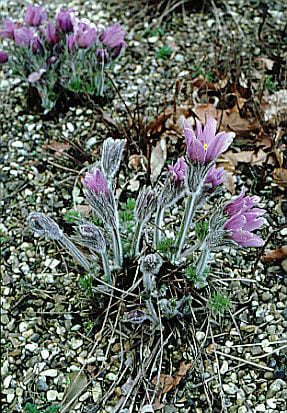Pulsatilla halleri
Haller's pasqueflower
An herbaceous perennial forming a clump to 20cm in height, with very hairy, deeply dissected leaves and erect, bell-shaped lavender-blue or violet-purple flowers up to 9cm across, followed by silky fruiting heads

Size
Ultimate height
0.1–0.5 metresTime to ultimate height
2–5 yearsUltimate spread
0.1–0.5 metresGrowing conditions
Moisture
Well–drainedpH
Acid, NeutralColour & scent
| Stem | Flower | Foliage | Fruit | |
| Spring | ||||
|---|---|---|---|---|
| Summer | Grey Silver | |||
| Autumn | ||||
| Winter |
Position
- Full sun
Aspect
East–facing or South–facing
Exposure
Exposed Hardiness
H5Botanical details
- Family
- Ranunculaceae
- Native to GB / Ireland
- No
- Foliage
- Deciduous
- Habit
- Clump forming
- Potentially harmful
- Can cause mild stomach upset if ingested. Wear gloves and wash hands after handling
- Genus
Pulsatilla are herbaceous perennials forming clumps of finely dissected leaves, with solitary, hairy bell-shaped or cup-shaped flowers followed by silky-plumed seed-heads
- Name status
Correct
- Plant range
- Europe
How to grow
Cultivation
Grow in fertile, very well-drained soil in full sun. It resents root disturbance and may be difficult to establish, so plant when small and leave undisturbed. Can also be grown in pots in an alpine house
Propagation
Propagate by seed sown in pots in an open frame as soon as seed is ripe. Propagate by taking root cuttings in winter
Suggested planting locations and garden types
- Gravel garden
- Patio and container plants
- Rock garden
Pruning
Leave faded flowers as seedheads are an attractive feature
Pests
Generally pest-free
Diseases
Generally disease-free
Love gardening
Sign up to receive regular gardening tips, inspiration, offers and more
View our Privacy Policy
Get involved
The Royal Horticultural Society is the UK’s leading gardening charity. We aim to enrich everyone’s life through plants, and make the UK a greener and more beautiful place.